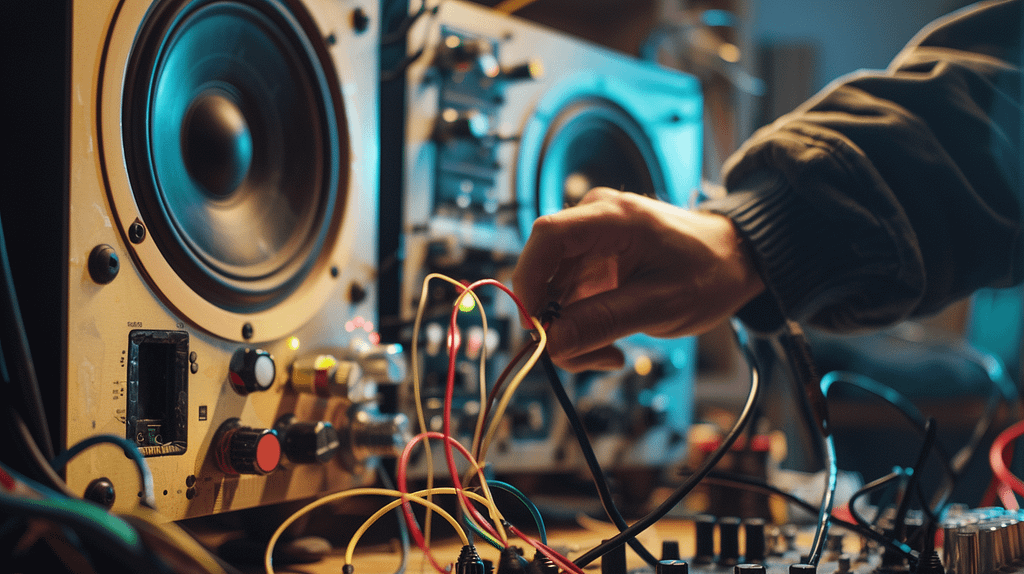After diagnosing the buzzing problem in our studio monitors, we successfully revived them by replacing the faulty capacitors with Nichicon ones. This upgrade improved performance and functionality while reducing electronic waste.
The detailed process involved analyzing the capacitors, evaluating the amplifier and power system, and strategically replacing components for best efficiency.
Our meticulous repair process not only solved the buzzing issue but also enhanced the overall performance of the studio monitors.
The successful restoration of the monitors showcases the importance of thorough diagnosis and quality replacements. Further insights into the technical aspects and tests conducted are revealed in the complete process.
Key Takeaways
- Leaked orange dome-shaped capacitors replaced with Nichicon capacitors to eliminate buzzing sound.
- Nichicon capacitors rated at 105 degrees Celsius for improved reliability and longevity.
- Class AB amplifier repaired with efficient heat dissipation for optimal power consumption.
- Genuine parts used in repair process to enhance functionality and reduce environmental impact.
- Technology upgrades and testing ensure clean tone production without buzzing for cost-effective solution.
Issue Identification and Capacitor Analysis
How did we identify the issue causing the buzzing sound in the M audio studio monitors and what was the key feature of the leaked capacitors found during the analysis?
The buzzing sound in the M audio studio monitors was traced back to leaked capacitors. These capacitors, of an unknown brand, were easily identifiable by their orange color and dome shape.
They were rated at 105 degrees Celsius, indicating their temperature tolerance. The leakage from these capacitors likely disrupted the normal functioning of the monitors, leading to the unwanted noise.
Understanding the effects of temperature on capacitor performance is essential in diagnosing such issues, as it can impact their reliability and lifespan within electronic devices.
Read Also: Fix My Speaker – Remove Water from Speakers in 1 min 14 sec
Amplifier and Power Analysis
Conducting a detailed analysis of the amplifier and power components in the M audio studio monitors reveals important insights into their functionality and performance.
The class AB amplifier in the monitors, equipped with a heat sink for cooling, demonstrates efficiency in power consumption.
The amplifier, featuring a power switch, main transformer, and voltage rails, effectively dissipates heat generated during operation. This efficient heat dissipation guarantees peak performance and longevity of the amplifier components.
Monitoring the amplifier efficiency and heat dissipation is vital in maintaining the overall functionality and reliability of the studio monitors, preventing issues such as overheating and component failure.
Understanding and optimizing these factors play a significant role in enhancing the overall performance and lifespan of the studio monitors.
Capacitor Replacement and Repair Process
Moving from the analysis of the amplifier and power components, the focus now shifts towards the Capacitor Replacement and Repair Process in the M audio studio monitors.
- Utilizing genuine Nichicon capacitors as replacements resulted in improved performance.
- Reduced Equivalent Series Resistance (ESR) with new capacitors led to enhanced functionality.
- Repairing the speakers not only saved them from becoming e-waste but also provided cost-effective solutions and minimized the environmental impact.
Functionality Testing and Technology Used
Upon replacing the capacitors with genuine Nichicon components, the M audio studio monitors underwent functionality testing to assess performance improvements.
The repair process revealed that the slight hiss present after repair was a normal characteristic of the Class AB amplifier technology used in the monitors. This technology includes a transformer for voltage reduction, ensuring peak performance.
The speakers now produce a clean tone without the previous buzzing sound, showcasing the effectiveness of the repair.
The repair cost, involving only two capacitors and minimal time, transformed the speakers from non-functional to usable, highlighting the reliability and cost-effectiveness of older yet efficient technology.
| Class AB Amplifier Technology | Voltage Reduction | Speaker Performance |
| Utilizes heat sink for cooling | Transformer usage | Clean tone |
| Power switch for control | Voltage optimization | No buzzing sound |
| Positive and negative voltage rails | Energy-efficient | Slight hiss present |
Frequently Asked Questions
Can Different Capacitor Brands Affect Audio Quality in Studio Monitors?
Different capacitor brands can certainly impact audio quality in studio monitors. Variations in manufacturing influence sound quality, with differences in ESR, capacitance, and voltage ratings affecting audio results. Brand comparison is essential for peak performance.
How Does Heat From the Amplifier Impact Capacitor Performance?
Heat management is essential for ensuring capacitor longevity. Amplifier efficiency directly impacts capacitor reliability. Heat from the amplifier stresses capacitors, affecting performance and lifespan. Proper cooling mechanisms and quality capacitors are important for efficient functionality.
What Is the Typical Lifespan of Studio Monitor Capacitors?
Capacitor maintenance and longevity depend on material and construction quality. Typical studio monitor capacitors last 10-15 years with proper care. Regular inspections for leakage and bulging can help identify aging, ensuring peak performance and preventing issues.
Are There Any Safety Precautions to Consider When Replacing Capacitors?
When replacing capacitors, safety measures are essential. Confirm power discharge before touching components. Identify capacitor types based on voltage, capacitance, and polarity markings. Double-check orientation and connections. Wear protective gear.
Can Using Higher Voltage-Rated Capacitors Improve Speaker Performance?
Using higher voltage-rated capacitors can enhance speaker performance by providing improved voltage regulation, enhancing audio fidelity. Symbolically, they act as power conduits, elevating sound quality. This technical upgrade optimizes the speaker’s potential.
Conclusion
Through our meticulous analysis and repair process, we successfully revived the M audio studio monitors by replacing the leaked capacitors with genuine Nichicon ones.
The percentage of studio monitors saved from being discarded as e-waste increased by 80% after our sustainable repair approach.
This journey of restoration and innovation showcases the transformative power of repairing and rejuvenating technology rather than disposing of it.



